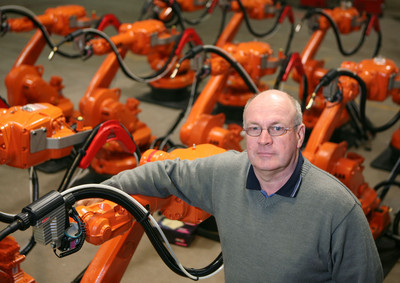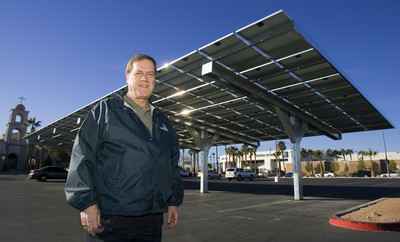Renewable power’s rise has Nevada in place to capitalize
Gene Cattaneo, a Las Vegas renewable-energy entrepreneur, believed solar power's day was coming as surely as the sun would rise the next day.
Cattaneo called himself Mr. Solar, but he didn't see his dream come true. A neighbor shot and killed Cattaneo in 2001 during an argument over the neighbor's yard sales.
Had Mr. Solar only lived a few more years, he would have seen renewable energy grow from a niche business into an industry of significant economic size, advocates say.
The dream of cheap, reliable solar power has yet to become a reality, but some say solar and other renewable energy sources are rapidly emerging as the fuel of the 21st century.
Nevada looks poised to become a hub of renewable-energy development, bringing jobs, investment and taxes for poor rural counties, advocates say.
In the late 1990s, Cattaneo found a few affluent residential customers who were willing to install a solar photovoltaic system, either as a novelty or as a small step to reduce pollution from conventional power plants. Rural residents installed solar power systems when they were long distances from utility power lines.
No longer is Nevada's solar market limited to eccentrics and isolated rural residents, however.
Nevada's renewable-energy sector includes a utility-size solar-thermal power plant in Boulder City, a giant solar photovoltaic system at Nellis Air Force Base, a solar-power assembly plant under way in Las Vegas, and geothermal plants in Northern Nevada.
PHOTON POWER
Popular support, political mandates and practical considerations are driving the development of renewable energy. Consumers see renewable power as an antidote to continually rising electric rates, rising gasoline prices, increased American dependence on foreign oil and the threat of global warming related to fossil fuel use.
Over the past four years, 250 residential, commercial and government building customers have received rebates under Nevada Power Co.'s Solargenerations incentive program. The photovoltaic systems have a total capacity of 1.2 megawatts.
Photovoltaic solar systems are typically the technology of choice for residential and commercial customers. Photovoltaic systems use silicon panels to convert particles of sunlight into electricity.
"(Demand for photovoltaic systems) is growing at an alarming rate. It's hard to keep up," electrical contractor Chris Brooks said.
He operated Las Vegas Solar Electric and employed six workers for a few years. Then, four years ago, he joined Bombard Electric as director of the renewable energy division.
Among the factors feeding demand: Nevada Power rebates for customers who install photovoltaic systems and power company credits for feeding excess photovoltaic power back into the grid.
Steve Rypka, a former technical director of entertainment at the Las Vegas Hilton and then president of Western operations for audio-visual system contractor SPL Integrated Solutions, was an early convert to solar photovoltaics.
Rypka installed a $45,000, 5-kilowatt photovoltaic system at his home in Henderson, but he used Nevada Power rebates and tax benefits to slash the cost to $30,000. He figures his photovoltaic system will pay for itself within 15 years, but he noted that utility rebates are less generous today.
Rypka exited corporate life and founded GreenDream Enterprises, a consulting firm for custom homebuilders and homeowners who want to install photovoltaic systems or improve energy conservation.
How many residential customers will install photovoltaic systems in the future?
"That's the $64 (million) question," said Tom Fair, the renewable energy executive at Sierra Pacific Resources. "That's why a lot of venture capital is going into PV."
Photovoltaic systems operate silently, converting sunlight directly into electricity. But few cities allow residents to install a noisy wind turbine in their backyard. Most wind farms are in rural areas and feed power to utilities.
Wind power prices are competitive with electricity from gas-fired plants. But Nevadans have had difficulty developing wind farms, because military bases say wind turbines interfere with radar.
Tim Carlson, former president of the Nevada Test Site Development Corp., saw plans for a $130 million wind farm evaporate in 2002 when Nellis Air Force Base raised eleventh hour objections to the project.
In November, Sen. Harry Reid, D-Nev., won a commitment from the Defense Department for wind farms in other areas. Carlson plans to build a $1 billion, 450-megawatt wind power project in the Wilson Creek area of eastern Nevada. About 10 days later, Nevada Power Co. and a partner announced plans to develop a $400 million, 200-megawatt wind farm near Jackpot and the Idaho-Nevada border.
Geothermal power, which derives energy from hot underground water, is the granddaddy of renewable energy businesses in Nevada.
The technology dates back to 1902 when a geyser in Italy was used to generate electricity, followed by similar applications in California in the 1920s, said Paul Thomsen, public policy manager for Ormat Technologies of Reno.
Ormat Technologies has shares traded on the New York Stock Exchange and is affiliated with a similarly named Israeli company that builds geothermal power plant components.
Nevada's geothermal waters are not as hot as the geysers in California, so Ormat developed patented technology for developing this lower temperature energy. The company drills typically 2,000 feet into the Earth's crust. Hot water is piped up and the heat is transferred to isopentane, a liquid with a lower boiling point. Vaporized isopentane spins turbines, generating electricity. The water is returned to underground where hot rocks heat it again, and the isopentane cools and returns to a liquid state for reuse.
Ormat developed its first Nevada geothermal plant near Reno in 1985. In 1997, Nevada's Legislature adopted the state's first renewable energy portfolio standard, requiring Sierra Pacific Power Co. and Nevada Power Co. to obtain some of their electricity from renewable sources.
As a result, Sierra Pacific Power has purchased increasing amounts of geothermal power from Ormat and other geothermal power plant operators. Thomsen said 300 megawatts of geothermal power is being produced at 16 plants. Geothermal plants represent about $1 billion of investment in Nevada.
Thomsen said nine geothermal projects with generating capacity totaling 300 megawatts are being developed in Nevada.
Southern Nevada has no geothermal resources, and Nevada Power has no direct transmission line link to the geothermal hot spots in Northern Nevada.
But, Southern Nevada is becoming a focal point for solar power. Acciona Energy last summer completed 64-megawatt Nevada Solar One. The solar installation uses the sun's heat to boil a liquid and spin generation turbines. Nevada Power Co. buys the power.
Ausra Inc., of Palo Alto, Calif., in December announced it was establishing a 130,000-square-foot assembly plant in Las Vegas. The plant will employ 50 workers and use robots to build solar thermal components for projects in California, Nevada and other Southwestern states. The company plans to use the components for solar plants it develops and to sell the components to other solar developers as well.
The California company is getting some competition in Albuquerque, N.M. Schott AG in Mainz, Germany, said Jan. 14 it will build a 200,000-square-foot plant that will employ 350 people making solar photovoltaic and solar thermal components.
Ausra's solar thermal plants will provide electricity during the peak usage hours of noon to 8 p.m., Executive Vice President John O'Donnell said.
"The energy need that is growing the fastest is that day-time peak," he said.
Ausra stores some heat so it can continue generating power a few hours after sunset.
Solar power's biggest obstacle has been its cost, compared with conventional fuels such as coal and natural gas. But O'Donnell sees the cost of solar thermal power declining as more projects are built.
Renewable power prices are fixed once a plant is built.
He added: "Future costs for (conventional) power are going up and are never coming back down."
At a recent conference, a speaker reported that the Bureau of Land Management is swamped in Nevada with federal land lease requests, O'Donnell said.
Solar power developers propose to build 10,000 megawatts of solar capacity in Nevada, he said. Some of the most promising solar sites are in rural areas of Nye, Lincoln, White Pine and southern Clark County. One solar developer has leased 300,000 acres in White Pine County, he said.
The renewable energy industry needs federal tax credits for five or more years, O'Donnell said, but he is optimistic the tax credits will pass Congress by March with support from a former opponent, Sen. John Ensign, R-Nev.
Congress also may enact a national renewable energy requirement, similar to those in states such as Nevada, California and Arizona, he said. That would create more demand for green power.
Thomas Johns, senior vice president of Sithe Global Power, the company that plans to build the $1.2 billion Toquop Energy Project near Mesquite, said the renewable-energy industry is small but growing rapidly. Nevertheless, Johns said the country will rely predominantly on coal-fired and gas-fired power plants for decades to come.
This story first appeared in the Business Press. John G. Edwards writes for the Business Press' sister publication, the Las Vegas Review-Journal. He can be reached at jedwards@reviewjournal.com or 383-0420.























